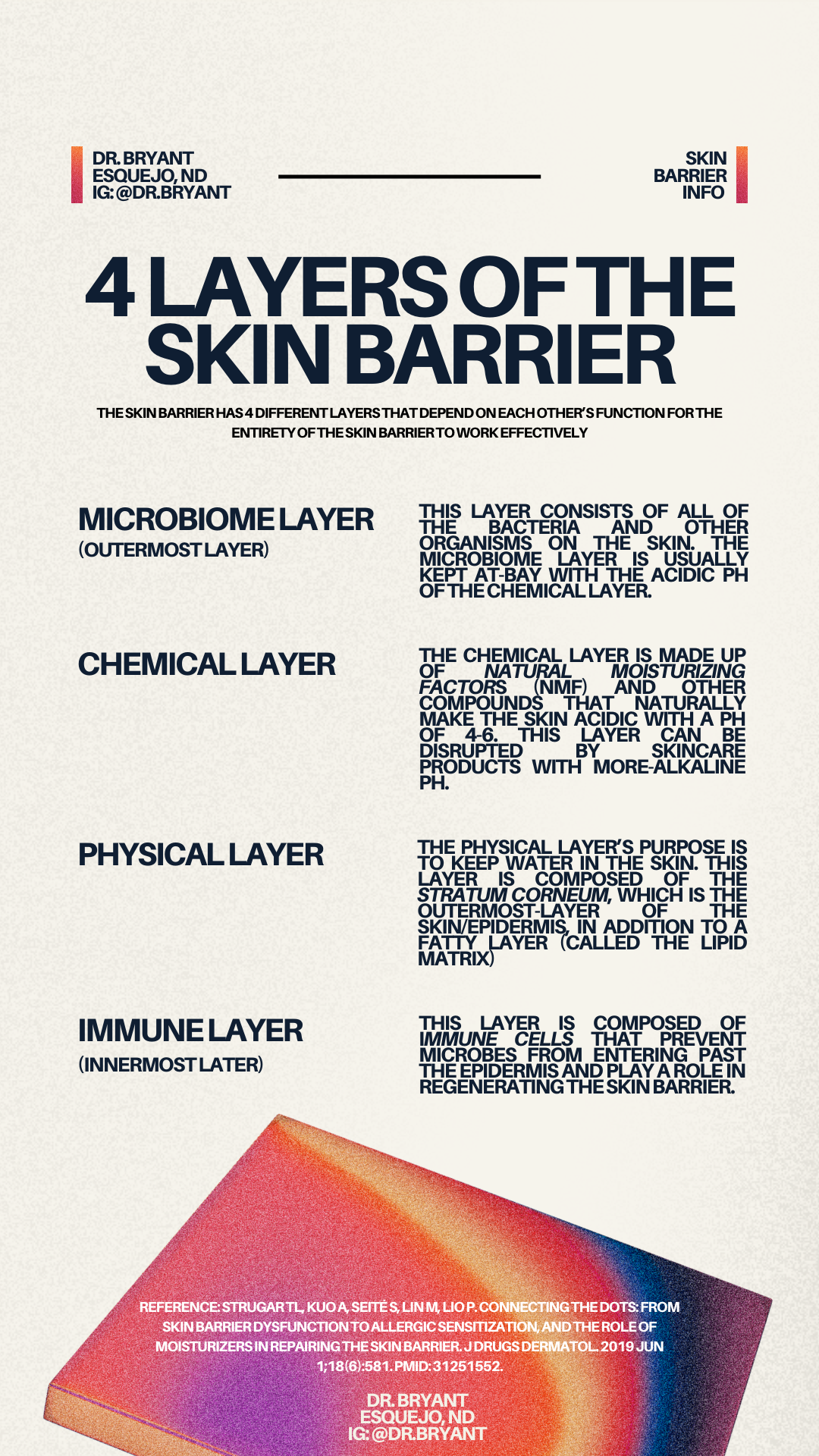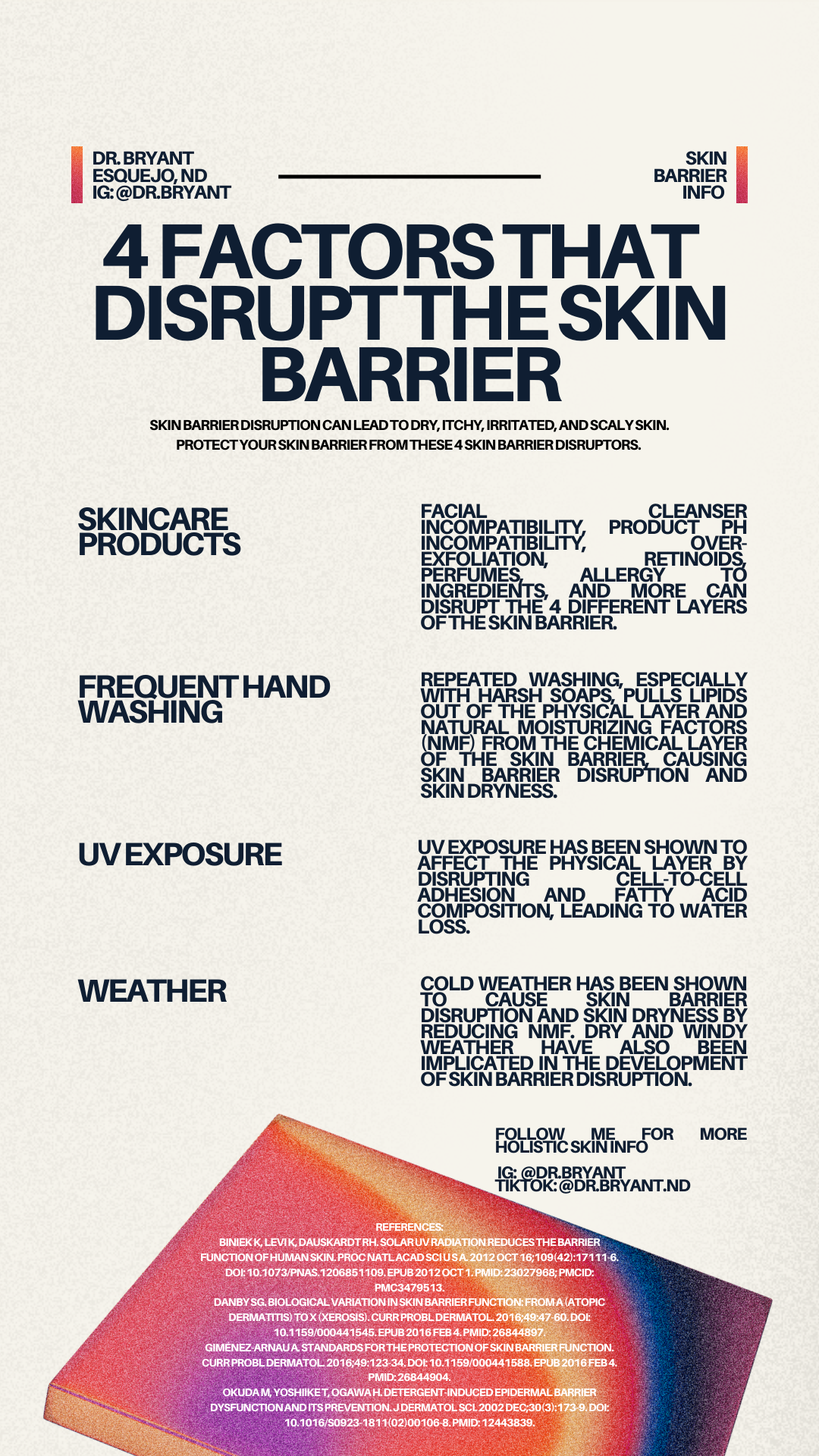Skincare for healthier skin
Skincare basics for the skin barrier
November is National Healthy Skin Month! So, let’s talk about ways to support healthier skin naturally and holistically.
As a licensed naturopathic doctor, I am an expert in both holistic & integrative medicine. And, I focus on holistic & integrative medicine for people with acne, eczema, and other skin issues.
WHEN PATIENTS FIRST SEE ME IN-OFFICE, I ALWAYS LET THEM KNOW THAT I SEE THEIR SKIN HEALTH AS A REFLECTION OF THEIR INNER HEALTH.
I also let them know that I am going use my expertise in holistic medicine to identify the underlying causes and triggers of their skin issues. And once identified, I aim to use that information to treat their skin & the underlying factors with integrative medicine - which means that I am trained in both natural & conventional treatment options.
There are some major themes that I tend to see with my patients that start them on the journey towards healthier & clearer skin.
And, those themes include:
Skincare routines to support skin from the outside-in
Skin nutrition & lifestyle practices to support skin health from the inside-out
We already talked about lifestyle & skin nutrition (click here for that article). Now, let’s talk about skincare routines!
DISCLAIMER: This article does not constitute as medical advise; is not meant to diagnose, prevent, treat, or cure any conditions or disease; and is meant for educational purposes only. Speak to your provider before starting anything new.
TOPICALS FOR HEALTHIER SKIN
THE SKIN BARRIER IS THE OUTERMOST PROTECTIVE LAYER OF THE SKIN. PROTECTING IT MEANS PROTECTING THE SKIN’S HEALTH & RESILIENCY
If someone is trying to reset their skincare routine, don’t know where to start when building a skincare routine, or just want some skincare tips, I feel that focusing on skin barrier health is the best place to start.
WHAT’S THE SKIN BARRIER?
THE SKIN BARRIER IS RESPONSIBLE FOR KEEPING WATER IN THE SKIN TO KEEP SKIN HYDRATED.
The skin barrier is also one of the body’s first defenses against: chemicals, UV radiation, disease-causing bacteria, & environmental exposures. And since it’s responsible for keeping skin hydrated, disruption to the skin barrier has been associated with skin irritation, eczema, rashes, skin dryness, acne, and more.
THE SKIN BARRIER IS LAYERED
THE SKIN BARRIER HAS 4 DIFFERENT LAYERS THAT DEPEND ON EACH OTHER’S FUNCTION FOR THE ENTIRETY OF THE SKIN BARRIER TO WORK EFFECTIVELY
The 4 layers of the skin barrier from the outermost to the innermost are:
MICROBIOME LAYER:
This layer consists of all of the bacteria and other living organisms on the skin. The microbiome layer is usually kept at-bay with the acidic pH of the chemical layer. When at balance, the microbiome layer is mainly composed of Staphylococcus epidermis and Corynebacterium bacteria. But, when the acidic pH of the chemical layer is off, it allows for the growth of Staphylococcus aureus and other disease-causing bacteria.
CHEMICAL LAYER:
The chemical layer is made up of natural moisturizing factors (NMF) and other compounds that naturally make the skin acidic with a pH of 4-6.
This layer can be disrupted by skincare products with more-alkaline pH.
PHYSICAL LAYER:
The physical layer’s purpose is to keep water in the skin. This layer is composed of the stratum corneum, which is the outermost-layer of the skin/epidermis, in addition to a fatty layer (called the lipid matrix). Corneocytes (the skin cells in the stratum corneum) naturally make the the lipid matrix by making enzymes and releasing lipids that make fats, such as ceramides and cholesterols
This layer can be disrupted when there is an imbalance in the types of fatty acids, such as omega-6 to omega-3 ratio, and changes in stratum corneum thickness.
IMMUNE LAYER:
This layer is composed of immune cells that prevent microbes from entering past the epidermis and play a role in regenerating the skin barrier.
What disrupts the skin barrier
EXTERNAL Factors that cause SKIN BARRIER DISRUPTION:
Skincare products/Physical irritants/Chemical irritants: Facial cleanser incompatibility, product pH incompatibility, over-exfoliation, retinoids, perfumes, allergy to ingredients, and more can cause disruption to different layers of the skin barrier, leading to dryness, irritation, and other symptoms of skin barrier dysfunction.
Frequent hand washing: Repeated washing, especially with harsh soaps, pulls lipids out of the physical layer and NMF from the chemical layer, causing skin barrier disruption and skin dryness.
Sunlight/UV exposure: UV exposure has been shown to affect the physical layer by disrupting cell-to-cell adhesion and fatty acid composition, leading to water loss.
Weather: Cold weather has been shown to cause skin barrier disruption and skin dryness by reducing NMF. Dry and windy weather have also been implicated in the development of skin barrier disruption.
INTERNAL Factors that cause SKIN BARRIER DISRUPTION:
Inherited predisposition/genetics
Food intolerances/allergies: Allergens that can cause systemic contact dermatitis include some spices, food additives, some herbs, balsam of peru, seafoods (due to nickel). In regards to eczema, we also know that there is a connection between food intolerances triggering or exacerbating eczema.
To check food intolerances with my patients, I do not go straight for food intolerance testing due to the possibility of false positives. To prevent false positively, I recommend a targeted and methodical elimination diet to identify food intolerances.
Gut microbiome: A small study completed on those with acne revealed that those with acne had different gut bacteria profiles compared to those without acne. And, is has been hypothesized that these acne-causing changes to gut microbiome/bacteria populations could arise because of bacteria-related products that cause the release of inflammatory markers into circulation.
There is also literature that suggests that there are associations between small intestinal bacterial overgrowth and Helicobacter pylori infection with rosacea; gut microbiome imbalance and eczema; and gut bacteria imbalance and psoriasis.
Whenever people see me for skin concerns AND they happen to also have gut symptoms, I want to confirm their gut microbiome populations with a stool analysis. The stool analysis that we do in the office is Diagnostic Solutions’ GI-Map, which uses PCR technology to amplify and concretely identify gut bacteria imbalances in the gut
If gut bacteria imbalance is confirmed, there are several natural options that I may recommend to my patients to help bring their gut bacteria populations back into balance.
Low thyroid hormone (hypothyroidism): Thyroid hormone is essential for controlling healthy epidermis development and function with animal models indicating that thyroid hormone being involved in skin cell production, wound healing, and hair growth.
And, those with hypothyroidism have low thyroid hormone, and can experience dry skin in addition to many other symptoms.
When people see me for skin issues, AND they also display low thyroid symptoms, I want to confirm what their thyroid health looks like, which is usually done with routine bloodwork.
If labs show low thyroid, there are several natural and integrative options that I may recommend to bring their thyroid back into balance to holistically support skin health.
SKINCARE FOR THE SKIN BARRIER
WHEN LOOKING FOR SKIN CARE INGREDIENTS THAT ADDRESS THE SKIN BARRIER, IT’S ALSO ABOUT UNDERSTANDING THE BUILDING BLOCKS OF WHAT IS IN EACH LAYER
Look for moisturizing factors that pull water into the skin, and look for elements that prevent water loss. Ingredients to look for are:
Ingredients that pull water into the skin (called humectants): Hyaluronic acid, glycerin, and gluconolactone (a type of polyhydroxy acid, or PHA)
Lipid replacement: Lipids are meant to keep water in the skin and prevent water loss. Some lipids in skincare include: Ceramides, cholesterol esters, palmitic acid, stearic acid, and candelilla wax.
Anti-inflammatories: Topical anti-inflammatories support various layers of the skin barrier. Some ingredients that are potentially anti-inflammatory include: Niacinamide, licorice extract (18-beta glycyrrhetinic acid), and gluconolactone.
In addition to these topicals, it may be worth someone’s while to consider occlusive skincare products as the last step to their routine to really seal in water in the skin and prevent water loss.
Beyond looking for the ingredients above, the following 5 elements will be worthwhile to consider to support skin barrier function:
Patch testing for skin irritation.
Making sure that the pH of the product is close to skin pH (pH 4-6) to prevent disruption of the microbiome layer.
Being mindful of when you’re excessively exfoliating as this can disrupt the physical barrier.
Watching if your current skin cleanser or any other skin products are making the skin feel too tight.
Remembering to always put on sunscreen and frequently re-apply
SKIN BARRIER ROUTINE
Remember to always speak to a doctor or a skin specialist before trying anything new, and make sure to ALWAYS patch test for possible irritation!!! Here is my current personal skincare routine that is aimed at supporting my skin barrier:
Step 1: Double cleanse.
I double cleanse morning and night. I start with a PHA cleansing oil on dry skin and rubbing off the night cream from the night before or the SPF from the day time. Then, put on some water to emulsify the oil and rub a bit more. As my skin is still wet, I use a gel cleanser to really clean my skin.
Step 2: Essence.
I use a hyaluronic acid-rich essence with niacinamide morning and night to prep my skin for the actives and serums that I use. I prefer an essence since they’re usually rich in hyaluronic acid, rich in moisture, and are not drying to the skin.
Step 3: Moisturizer.
I sometimes use a hyaluronic acid moisturizer if my skin is especially dry. Note: Hyaluronic acid products work best on damp skin, and it would be best to apply hyaluronic acid right after an essence or washing the face while it is still damp.
Step 4: Lipids.
I use a non-comedogenic facial oil morning and night to seal in the moisture from the hyaluronic acid.
Step 5: Daytime vs. Nighttime
Daytime SPF: My last step, if I am getting ready for the day, is a tinted sunscreen with iron oxides to protect my skin barrier from sun damage.
Nighttime sleeping mask: My last step, if I am getting ready for bed, is a ceramide-rich sleeping mask to keep all of that moisture in my skin
Takeaways
I believe that supporting the skin barrier is an essential component when supporting skin health, and needs to be the first thing that comes to mind when building a holistic skincare routine. And when I say holistic skincare routine, that means supporting the skin with essential & compatible topicals AND supporting inner health. These are 4 takeaways from this article:
The skin barrier is necessary for skin resiliency, skin hydration, optimal skin performance, and overall skin health. And skin barrier disruption that been linked to skin irritation, eczema, rashes, skin dryness, acne, and more.
There are 4 layers of the skin barrier that rely on each other for the entire skin barrier to perform optimally: The microbiome layer, the chemical layer, the physical layer, and the immune layer.
There are several skincare mistakes that can disrupt the skin barrier, such as: Excessive washing; using products with incompatible pH; over-exfoliation; retinoid use; and more. Also, don’t forget to patch test!
If changing skincare products and skincare routine does not positively affect the skin barrier, there could be internal factors that are disrupting the skin barrier such as: Gut health, diet, and thyroid hormone imbalance.
Skin health is a reflection of inner health. Start supporting your skin from within, as skincare products are only as effective as the foundation they sit on.
Want to learn about skin health from a holistic & integrative POV? Read my articles on:
To stay up-to-date about future articles on my website, click here sure to sign up for my email newsletter. And, if you want to set up an appointment with me, click here.



